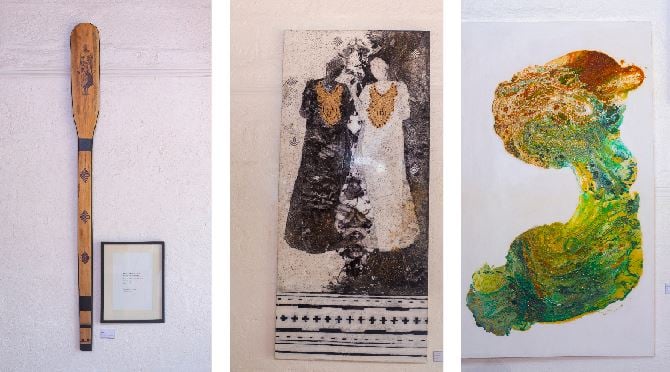Prime
Another Look One exhibition ongoing

The exhibition brings together young painters who have something to say with their art. Photo/Andrew Kaggwa
What you need to know:
- Juma Ntege’s works mainly talk about climate change and unlike most of the works on display, he is very minimalistic with colour.
If there is one thing that is difficult for a fresh visual artist, it is getting booked for exhibitions. Most galleries want an artist with a reputation and the ability to pull collectors to spend and buy.
This is the reason Xenson Artspace’s annual Look One exhibition is always a big deal. Initially, Look One was the exhibition that opened the gallery’s year; however, this time, when they held for female artists in March and in April, they held their annual Look One on April 20.
The exhibition brings together seven visual artists: Agamba Solomon Paebo, Armani Azhari, Aya Babiker, Anilla Nassuuna, Kiyingi Henry, Wafula Mario, and Nyege Jumah.
The objective of the exhibition is to allow young and emerging artists to exhibit their works in a professional way in an art gallery.
According to the exhibition catalogue, each artist has a distinct and profound story to share through their art forms. This will be the first professional exhibition for each of the artists, allowing them to be the first to experience their work and support them.
Paebo Solomon Agaba, for instance, mixes bits of digital art and photography while exploring themes around identity, mental health, and social justice within African youth culture. Driven by a personal experience of resilience, Peabo utilises photography and digital art to capture the emotional expression and creative spirit of young people.
Then there is Amani Azhari from Sudan, who has participated in numerous internal exhibitions in her home country and is currently based in Nairobi.
Azhari’s work is rich in colour and very inviting. Her subject is herself, spotting polka dot dresses of different shades in all the paintings.

Azhari finds inspiration in girls’ sessions where they express their thoughts and experiences, which often silences them with numerous restrictions.
Aya Babiker, also from Sudan, works with paper and is also a bust of colour.
Anilla Nassuuna is very experimental both with colour, material, styles, and the way she chooses to finish her works. She is one of the artists whose works do not look alike in any way. She experiments with canvas, backcloth, thread and water colours. It is hard to really know where her mind is as an artist, but it is visible that she has a lot to give.
Another amazing one is Kiyinji, who uses jerrycans as a subject in all his works. He seems to criticise Uganda’s social and political lifestyle that mainly revolves around gossip and idle talk. He manages to create the idea that Ugandans are empty yellow jerrycans that laugh their pain away and drink about their sorrow. But of course, the meaning of all these pictures could be subjective.
Wafula’s application of thick colour layers and textures almost brings a monochrome effect to his paintings. Most of them are portraits, but it is hard to know if there is a deeper meaning hidden in the layers.
Juma Ntege’s works mainly talk about climate change and unlike most of the works on display, he is very minimalistic with colour. His works are clean – almost white most of the time – yet he still manages to communicate the mess around climate change.
In a nutshell, the exhibition brings together a brilliant group of painters who have something to say. Whether those seeing the exhibition get the message,that is a story for another day.




